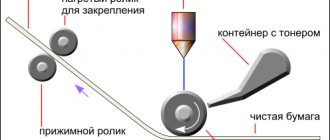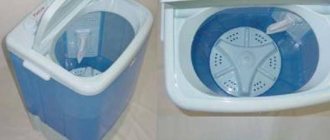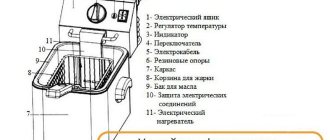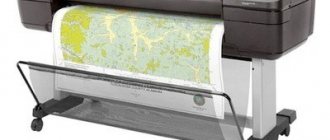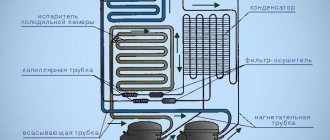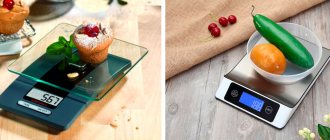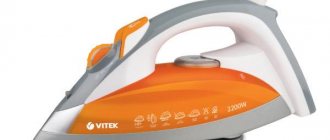Requirements for a storage water heater
Before using a water boiler, you need to familiarize yourself with its main characteristic features:
- When using storage heaters, it takes some time for the water temperature to rise to the optimal temperature.
- Water pressure depends on the pressure in the system. Accordingly, storage and instantaneous water heaters will have different operating conditions.
- Instantaneous water heaters are cheaper than instantaneous water heaters, but more expensive to operate, since they constantly consume electricity while the tap is open.
- The principle of operation of a storage heater is to heat pre-accumulated water to a high temperature and then maintain it at this level. This also consumes electricity, but in much smaller quantities.
Design of a storage water heater Source popechi.ru
- Household electric water heaters do not have special requirements for wiring reliability. When connected to a water supply, particularly high pressure is not required.
- Gas water heaters operate from a regular gas distribution network, but their connection must be carried out by specialists.
- Storage boilers require regular maintenance, especially if there is water in the water supply with a high content of impurities.
- It is not advisable to use water from storage heaters for drinking. For flow-through systems, this restriction does not apply.
- Boilers usually take up quite a lot of space, especially floor-standing models with a large tank.
An example of placing a water heater with hidden communications Source hobot.by
Secrets to the longevity of a storage water heater
First system launch
We will not even consider installing the device, because it must be done by specialists.
Otherwise, your equipment will lose the right to warranty repairs. It is advisable to entrust the first launch to the experts. But if this moment was missed, you can start the system yourself.
Before starting the storage water heater, open the hot water tap
The sequence of actions is as follows:
- First, you need to check how well the technicians did the installation, and whether there are any water leaks. To do this, disconnect the water heater from the power supply and fill it with cold water.
- Be sure to open the hot water tap to see when the boiler is completely full. As soon as water comes out of the tap, you know: the water heater is full. Close the tap and inspect the structure from all sides.
- After making sure that there are no leaks at the connections, plug the device into the outlet and set the desired water heating mode.
Rules for using a working device
There are two opinions:
- Never disconnect the device from electricity and keep it in constant operation mode.
- Disconnect from the network so that it does not waste extra energy if the water is no longer used today.
It seems that the second option looks more economical, but in reality it is not so. It is easier for the device to maintain the same water temperature than to heat it from scratch. Experts believe that a constantly filled water heater is less susceptible to corrosion. In addition, the disconnected device must be in a room with a temperature of at least 5˚, so that summer residents who cannot provide such a thermal regime will say goodbye to the heater after winter. The only option in which it is recommended to turn off the device is periodic use (for example, once a month or a week).
The second point that should be taken into account during installation is mandatory grounding. This is a matter of safety for the whole family, so make sure that the masters do not forget about this nuance.
When starting the system, check if there is water in the tank. A switched on empty device will instantly fail.
Heating mode selection
Some owners set the heating temperature low, hoping to save on electricity. But in this case, the efficiency of the device decreases, and real savings will not be achieved.
And yet, an economical mode is provided in some systems, and the operating instructions for the water heater should tell you about this. This is also indicated by the letter E on the temperature scale. But how do these savings manifest themselves?
It turns out that manufacturers don’t have energy consumption in mind at all. Mode E means that the water will heat up to exactly 55˚. At this degree (not higher or lower!) there is the lowest level of scale formation. And the owners will actually save on cleaning the tank, because they will do it much less often.
If the water in the house is too hard, then you need to frequently descale the tank, otherwise you will have to change the heating element
Setting temperatures below 55˚ is not recommended, because 30-40˚ is the optimal environment for the development of bacteria, which will lead to fungal deposits on the walls of the tank. The water will begin to smell like mold, and it will be very difficult to eliminate the smell later.
If you need to drain the water from the heating tank, we advise you to watch this video:
Water heater device
The operating principle of a storage water heater involves intensive transfer of thermal energy to water for initial heating. Then the heater turns off and starts from time to time to maintain the required temperature. If a large amount of hot water is consumed at a time, the heater again switches to intensive heating mode.
In a flow-through boiler, the heating element must heat the water constantly. But since boiling water is not needed at the outlet, the water temperature usually does not exceed 40-60 °C. But even for this you have to spend quite a lot of electricity. Gas heaters are much more economical - they are all flow-type.
Water heater device:
- A reservoir filled with water from a water supply under pressure. In a flow type there is a coil through which water flows.
- Housing with a thick thermal insulation layer.
- Heating element or magnesium anode. If the boiler is gas - chimney and burner. They will ensure heating of water in the container.
- A pipe that supplies cold water and a pipe for discharging hot water from the boiler. It is often equipped with a special valve, which opens when the pressure in the heater increases.
Boiler connection diagram Source otoplenie-gid.ru
- An electronic control unit, which receives data from sensors and displays performance indicators on the display panel, regulates the functioning of the entire boiler. There are keys for manual settings of heating indicators (maximum temperature mode and heating speed).
See also: Catalog of companies that specialize in electrical work, design and installation of water supply and sewerage
What is water heater maintenance?
Heating element in the boiler Electric boilers require regular maintenance. It is as follows:
- At least once every 6 months, completely empty the water from the device;
- remove the heating element from the housing and carefully inspect it; if there is limescale on the heating element, it should be cleaned;
- when the magnesium anode dissolves on the heating element, replace it; the anode should be replaced once a year; if the water is hard, the new element will have to be replaced more often.
Heating element in the boiler
Types of storage water heaters
Today, manufacturers offer several types of devices for autonomous hot water supply. Each of them has its own characteristics, depending on the energy carrier used and the method of heating water. The home owner chooses a boiler that is best suited in all respects.
Electric boilers
This is a tank, mainly round or oval in shape, which is enclosed in a heat-insulating layer and covered with a decorative cover. The working tank is made of enameled steel or stainless steel.
You can choose an electric water heater to suit any need Source o-vannoy.ru
At the bottom of the tank there is an electric heating element that heats the water to the temperature set on the thermostat. Usually it is 85 degrees.
While there is no water intake, the heater device assumes maintaining the set temperature indicators in autostart mode and turning off the heating element. That is, the heating element will turn off when the water temperature exceeds 85 degrees, and will start again when the water cools down, for example, to 75 °C.
In general, this is the entire answer to the question of how an electric storage water heater works.
Indirect heating boilers
To understand how an indirect heating water heater works, let’s get acquainted with its structure. The main nuance of their work is that they basically do not heat the water themselves, but take heat from the heating circuit of the house. That is, before going into the heating system, water from the boiler passes through a coil inside the indirect heating boiler and gives off some of the heat to the water in the tank. The water from the heating system and inside the boiler do not mix, so heating is called indirect.
Structure of an indirect heating boiler Source etc-tkr.com.ua
Regular use
There are two opinions on the question of how to properly use an electric storage water heater. Some believe that the device must be constantly connected to electricity, while others believe that it must be disconnected from the network during all idle times.
The second option looks more economical, but only at first glance. It is easier for a boiler to maintain the water temperature than to heat it up every time. Another argument in favor of the first opinion is that a filled tank corrodes more slowly. The device should be disconnected from the network only in cases where it is not planned to be used for a long time (until the next summer season or until the next water outage).
Video description
For a clear overview of the features of gas boilers, watch this video:
The advantage of boilers is that they are able to supply a large amount of water for domestic hot water needs. And unlike storage electric boilers, they do not require a break to heat the next portion of water.
Flow heaters
Now let’s learn more about how a flow-type electric boiler works. Like gas, it is designed to quickly heat tap water.
The heat source here is electric heating elements, which can be located both inside the water pipe (wet) and outside (dry). They will turn on when a hot water tap is opened, for which an additional sensor is installed in the system.
Advantages of such devices:
- heated water is supplied immediately and for an unlimited time;
- The operation of such water heaters is easy to automate.
Flaws:
- high energy consumption;
- It is difficult to immediately adjust the heating level, which depends on the pressure in the water supply and the initial temperature of the water in it.
Instantaneous water heaters are smaller in size Source homeli.ru
Rules for using a water heater
Before using the boiler, you need to consider the following rules:
- Initially, the device needs to be installed. Proper installation will determine the service life of the device. When installing, you must comply with the manufacturer's requirements.
- Before turning on the heater, you must close the hot water riser. Then the boiler output is connected to it and the system is started. To disconnect, you need to perform the steps in the reverse order.
- When the homeowner leaves for an extended period of time, the heater is disconnected from the power supply.
- Maintenance of the device is required annually.
- The higher the water temperature is set, the more it can be diluted and the slower it will be consumed.
- When there are a large number of consumers in the house, the maximum temperature is set.
Boiler market overview
Today, there are many Russian and foreign manufacturers on the domestic water heater market, although the latter are predominantly dominant: MTS, Lorenzi Vasco and others.
Many manufacturers are opening full-cycle production in Russia, producing basic components. This allows us to reduce the price on the domestic market and increase the availability of products for a wide range of consumers. One of these developers is considered to be the Italian corporation Ariston, whose heaters have actually already become a domestic brand.
It has been successfully operating in the Russian market for a long period of time, opening its factories and providing Russians with high-quality heaters. The range of models includes various types of water heating equipment.
Ariston is one of the most recognizable brands of water heaters Source goods.ru

